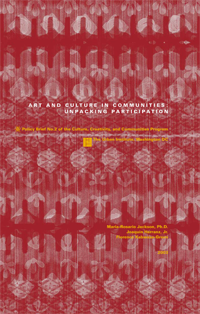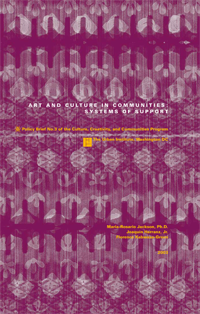Corporate Philanthropy
Corporate Philanthropy
In late January GIA polled its 309 member organizations about their organization's responses to the economic downturn. 117 (38%) members responded, which provides a healthy sample of the membership.
Members reported their expected 2009 arts grantmaking would likely compare to 2008 as follows:
- 41% expected that 2009 would be the same as 2008.
- 13% expected that it would be reduced to 90% of 2008.
- 12% expected that it would be reduced to 80% of 2008.
- 11% expected that it would be reduced to 70% of 2008.
Memo
To: David Landers
From: Holly Sidford
Re: December 4 Conference Call
Date: December 29, 2008
As promised, this memo summarizes the main points I made during the conference call of Northwest area foundations on December 4. I apologize for the delay in getting these notes to you; pre-holiday deadlines seem to have stolen several weeks of my time. But I suspect with all the snow you've had, you may have lost a few work days yourself. I hope you are shoveled out and back in business.
Read More...Alana Conner Snibbe, in this article published by the Stanford Social Innovation Review, explores the often misleading relationship between nonprofit overhead and efficiency, and the pitfalls inherent in measuring a nonprofit's well being by its overhead ratio.
Available free online from Stanford Social Innovation Review
Read More...In a broad, historic shift, and under a variety of names - like cause marketing or strategic philanthropy - large corporations are changing the way they view their charitable donations. Most appear to want a closer alignment with their business objectives
Available free online from the Stanford Social Innovation Review
Download:
![]() Philanthropy, Inc.
Philanthropy, Inc.
(857Kb)
We may go to the opera, live theater, or the symphony, but we don't stop to really think about how much these performances can mean to our daily lives and to our communities. Those performing arts organizations have been concentrating on this issue for years.
Read More...This report focuses on two issues: (1) the usefulness of existing arts and culture data for the purposes of developing neighborhood indicators and (2) the ways in which art and culture are understood and valued at the neighborhood level by those who live and work there. Included are a discussion of the reconnaissance efforts, field work, workshops, pilot and case studies conducted; a review of existing arts and culture data collection practices and their usefulness for developing neighborhood indicators; and an analytical framework for identifying indicator types.
Read More...2010, 12 pages, The Urban Institute, 2100 M Street NW, Washington, D.C., 20037, (202) 833-7200 http://www.urban.org
Download:
Read More...2010, 72 pages, The Urban Institute, 2100 M Street NW, Washington, D.C., 20037, (202) 833-7200 http://www.urban.org
Download:
Read More...A report from the 1994 arts education conference of Americans for the Arts co-founding organization, the American Council for the Arts. As stated in the introduction, "The historical relationship between business and the arts has been governed by a single set of terms. The arts—and arts education—have looked to the private sector for financial support and patronage, and business has looked to the arts to enrich the lives of their employees and of the community, but not for any strictly business benefit.
Read More...
This important new study, released in June 2002, demonstrates conclusively that the nonprofit arts industry has a significant economic impact on local and national economies. And, for the first time, in addition to spending by arts organizations, information has been gathered on event-related spending by arts audiences. Americans for the Arts worked with 91 community partners from across the U.S. to collect expenditure data for this study.
Read More...

